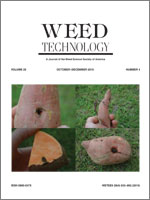Field experiments were conducted at two locations in Missouri in 2012 and 2013 to evaluate herbicide programs in 4-hydroxyphenylpyruvate dioxygenase (HPPD)-inhibitor-resistant soybean, referred to as FG72 soybean, and their tolerance to four HPPD-inhibiting herbicides. At the Columbia location, PRE followed by (fb) POST and two-pass POST treatments provided 97% or greater control of all weeds except ivyleaf morningglory. At Moberly in 2012, PRE fb POST treatments provided 95% or greater control and 100% biomass reduction (BR) of glyphosate-resistant (GR) waterhemp, with the exception of isoxaflutole at 0.04 kg ha−1 plus S-metolachlor at 0.6 kg ha−1 plus metribuzin at 0.2 kg ha−1. In 2013, PRE fb POST treatments provided greater than 89% control and 93% BR. Two-pass POST treatments of isoxaflutole plus glyphosate always provided greater control and BR of GR waterhemp compared with glyphosate fb glyphosate. However, at Columbia, where glyphosate-susceptible weeds were present, there were no differences in control or BR between two-pass POST treatments. In the soybean tolerance experiment, isoxaflutole provided the lowest levels of injury. Applications of tembotrione at the 1× rate resulted in the greatest injury in both years. Topramezone at the 1× rate always provided less injury than tembotrione, but was always similar in BR. The 2× rates increased soybean injury over the 1× rate for the third trifoliate (V3) application, but not for the PRE and first-flower (R1) applications. V3 and R1 applications of isoxaflutole and mesotrione resulted in similar injury, height reduction, and BR to soybean 28 d after application in 2012 and 2013. Overall these results indicate that FG72 soybean could allow the use of HPPD-inhibiting herbicides such as mesotrione PRE along with isoxaflutole PRE and POST to provide an additional herbicide mechanism of action that was not previously available in soybean.
Nomenclature: Glyphosate; isoxaflutole; mesotrione; tembotrione; topramezone; common waterhemp, Amaranthus rudis Sauer; ivyleaf morningglory, Ipomoea hederacea L.; soybean, Glycine max L.
En 2012 y 2013, se realizaron experimentos de campo en dos localidades de Missouri para evaluar programas de herbicidas en soja resistente a inhibidores de 4-hydroxyphenylpyruvate dioxygenase (HPPD), llamada soja FG72, y su tolerancia a cuatro herbicidas inhibidores de HPPD. En la localidad de Columbia, tratamientos PRE seguidos por (fb) POST y tratamientos con dos aplicaciones POST brindaron 97% o más control de todas las malezas excepto Ipomoea hederacea. En Moberly en 2012, tratamientos PRE fb POST brindaron 95% o más control y 100% de reducción de la biomasa (BR) de Amaranthus rudis resistente a glyphosate (GR), con la excepción de isoxaflutole a 0.04 kg ha−1 más S-metolachlor a 0.6 kg ha−1 más metribuzin a 0.2 kg ha−1. En 2013, tratamientos PRE fb POST brindaron un control superior a 89% y 93% BR. Tratamientos con dos aplicaciones POST de isoxaflutole más glyphosate siempre brindaron mayor control y BR de A. rudis GR al compararse con glyphosate fb glyphosate. Sin embargo, en Columbia, donde malezas susceptibles a glyphosate estaban presentes, no hubo diferencias en el control o BR entre tratamientos con dos aplicaciones POST. En el experimento de tolerancia de la soja, isoxaflutole causó el menor nivel de daño. Aplicaciones de tembotrione a una dosis de 1× resultaron en el mayor daño en ambos años. Topramezone a una dosis de 1× siempre causó menor daño que tembotrione, pero BR fue siempre similar. Las dosis de 2× aumentaron el daño en la soja a niveles supe





